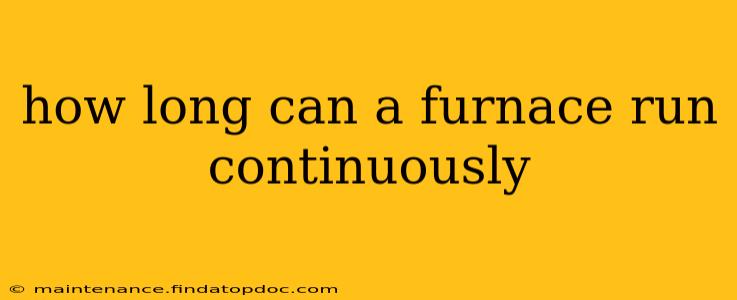A furnace shouldn't run continuously for extended periods. While the exact timeframe depends on several factors, constant operation indicates a potential problem requiring professional attention. This article explores the ideal runtime, factors influencing it, and what to do if your furnace seems to be running incessantly.
What is the Normal Run Time for a Furnace?
A typical furnace cycle involves a period of heating followed by a period of rest (or "off-cycle"). A balanced system might run for 15-20 minutes, then shut off for a similar duration, continually adjusting based on the thermostat setting and the home's temperature. However, this is just a general guideline. Newer, more efficient furnaces might have shorter cycles.
The key isn't the exact duration, but the balance between on and off cycles. Continuous operation is a warning sign.
Why is My Furnace Running Continuously?
Several issues can cause a furnace to run non-stop. Let's address some common culprits:
1. Thermostat Issues:
- Incorrect Settings: A thermostat set too low in a cold environment will force the furnace to work overtime. Double-check your settings and ensure they are appropriate for the outside temperature.
- Malfunctioning Thermostat: A faulty thermostat can send incorrect signals to the furnace, leading to continuous operation or even failure to turn off. Consider replacing the batteries or, if necessary, the entire unit.
2. Insufficient Airflow:
- Clogged Air Filter: A dirty air filter restricts airflow, forcing the furnace to work harder and potentially run continuously. Regularly changing your air filter (ideally every 1-3 months) is crucial.
- Blocked Vents: Obstructed vents restrict airflow throughout your home, leading to similar issues. Ensure all vents are open and free from obstructions.
- Problems with the Blower Motor: A malfunctioning blower motor might not circulate air properly, causing the furnace to overheat and potentially run continuously as a safety mechanism.
3. Low Gas Pressure (for gas furnaces):
Inadequate gas pressure can prevent the furnace from achieving the desired temperature efficiently, leading to prolonged run times. This requires a professional gas technician to diagnose and fix.
4. Problems with the Heat Exchanger:
A cracked or damaged heat exchanger is a serious safety hazard. It can cause the furnace to run continuously and may even leak dangerous gases. Never attempt to repair a heat exchanger yourself. Call a qualified HVAC technician immediately.
5. Refrigerant Issues (for heat pumps):
If your heating system is a heat pump, low refrigerant levels can cause it to run constantly and struggle to achieve the desired temperature. A technician needs to check and recharge the refrigerant if necessary.
How Long is Too Long for a Furnace to Run?
There's no magic number. If your furnace runs for an hour or more without pausing, especially in moderate temperatures, it's a significant cause for concern. Pay attention to the balance of on and off cycles. Consistent, prolonged run times signal a potential problem that needs professional assessment.
What Should I Do if My Furnace is Running Continuously?
Don't ignore a continuously running furnace. This could indicate a serious problem that might lead to further damage or even safety hazards. Here's what to do:
- Check the obvious: Start by inspecting the air filter, vents, and thermostat settings as described above.
- Call a qualified HVAC technician: If the problem persists after checking these basic elements, contact a professional HVAC technician for a thorough inspection and repair. Attempting to fix complex issues yourself could lead to further damage and safety risks.
By addressing the root cause promptly, you can ensure your heating system's longevity and your family's safety. Regular maintenance is essential for preventing such issues.
